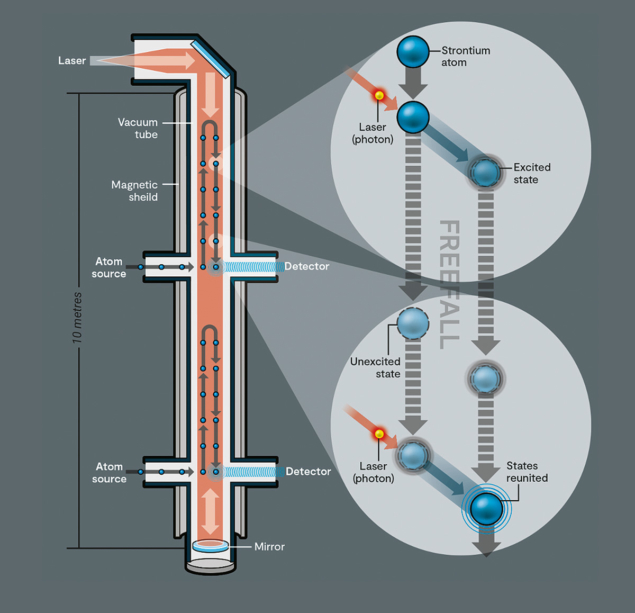
A particle physics-led experiment called AION (Atomic Interferometric Observatory and Network) is one of several multidisciplinary projects selected for funding by the UK’s new Quantum Technologies for Fundamental Physics programme. The successful projects, announced in January following a £31 million call for proposals from UK Research and Innovation (UKRI), will exploit recent advances in quantum technologies to tackle outstanding questions in fundamental physics, astrophysics and cosmology.
We have an opportunity to change the way we search for answers to some of the biggest mysteries of the universe
Mark Thomson
UKRI and university funding of about £10 million (UKRI part £7.2 million) will enable the AION team to prepare the construction of a 10 m-tall atomic interferometer at the University of Oxford to explore ultra-light dark matter and provide a pathway towards detecting gravitational waves in the unexplored mid-frequency band ranging from several mHz to a few Hz. The setup will use lasers to drive transitions between the ground and excited states of a cloud of cold strontium atoms in free fall, effectively acting as beam splitters and mirrors for the atomic de Broglie waves (see figure). Ultralight dark matter and exotic light bosons would be expected to have differential effects on the atomic transition frequencies, while a passing gravitational wave would generate a strain in the space through which the atoms fall freely. Either would create a difference between the phases of atomic beams following different paths – the greater their separations, the greater the sensitivity of the experiment.
“AION is a uniquely interdisciplinary mission that will harness cold-atom quantum technologies to address key issues in fundamental physics, astrophysics and cosmology that can be realised in the next few decades,” says AION principal investigator Oliver Buchmueller of Imperial College London, who is also a member of the CMS collaboration. “The AION project will also significantly contribute to MAGIS, a 100 m-scale partner experiment being prepared at Fermilab, and we are exploring the possibility of utilising a shaft in the UK or at the LHC for a similar second 100 m detector.”
Six other quantum-technology projects involving UK institutes are under way thanks to the UKRI scheme. One, led by experimental particle physicist Ruben Saakyan of University College London, will use ultra-precise B-field mapping and microwave spectrometry to determine the absolute neutrino mass in tritium beta-decay beyond the 0.2 eV sensitivity projected for the KATRIN experiment. Others include the use of new classes of detectors and coherent quantum amplifiers to search for hidden structure in the vacuum state; the development of ultra-low-noise quantum electronics to underpin searches for axions and other light hidden particles; quantum simulators to mimic the extreme conditions of the early universe and black holes; and the development of quantum-enhanced superfluid technologies for cosmology.
The UKRI call is part of a global effort to develop quantum technologies that could bring about a “second quantum revolution”. Several major international public and private initiatives are under way. Last autumn, CERN launched its own quantum technologies initiative.
“With the application of emerging quantum technologies, I believe we have an opportunity to change the way we search for answers to some of the biggest mysteries of the universe,” said Mark Thomson, executive chair of the UK’s Science and Technology Facilities Council. “These include exploring what dark matter is made of, finding the absolute mass of neutrinos and establishing how quantum mechanics fits with gravity.”





